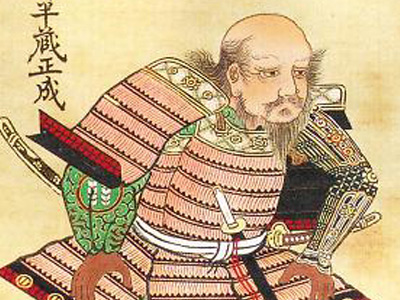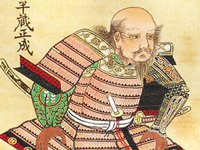Hattori Hanzō (1542-1597)

Hattori Hanzō (服部 半蔵, c. 1542 – January 2, 1597), also known as Hattori Masanari or Hattori Masashige (服部 正成), was a famous samurai of the Sengoku era, credited with saving the life of Tokugawa Ieyasu and then helping him to become the ruler of united Japan. Today, he is often a subject of varied portrayal in modern popular culture.
Life
Born the son of Hattori Hanzō Yasunaga (服部 半蔵(半三) 保長), a minor samurai in the service of the Matsudaira (later Tokugawa) clan. He would later earn the nickname Oni no Hanzō (鬼の半蔵, Demon Hanzō) because of the fearless tactics he displayed in his operations; this is to distinguish him from Watanabe Hanzo (Watanabe Moritsuna), who is nicknamed Yari no Hanzō (槍の半蔵 Spear Hanzō).
Though Hanzō was born and raised in Iga, Mikawa Province (now Iga-chō, Okazaki, Aichi), he often returned to Iga Province, home of the Hattori family. He fought his first battle at the age of 16 (a night-time attack on Udo Castle) made a successful hostage rescue of Tokugawa's daughters in Kaminogō Castle in 1562 and went on to lay siege to Kakegawa Castle in 1569. He served with distinction at the battles of Anegawa (1570) and Mikatagahara (1572).
According to the Kansei Chōshū Shokafu, a genealogy of major samurai completed in 1812 by the Tokugawa Shogunate, Hattori Hanzō rendered meritorious service during the Battle of Mikatagahara and became commander of an Iga Unit consisting of 150 men. During Mikatagahara, he captured a Takeda spy named Chikuan and when Takeda's troops invaded Totomi, Hanzō counter-attacked with only 30 men at the Tenryu river.
During the Tenshō Iga War he planned a brilliant defense of the ninja homeland in Iga province in 1579 against Oda Nobukatsu the second son of Oda Nobunaga and fought a valiant but ultimately hopeless effort to prevent the Iga province from being eliminated by forces under the personal command of Nobunaga himself in 1581. His most valuable contribution came in 1582 following Oda Nobunaga's death, when he led the future shogun Tokugawa Ieyasu to safety in Mikawa Province across Iga territory with the help of remnants of the local Iga ninja clans as well as their one-time rivals in Koga. According to some sources, Hanzō also helped in rescuing the captured family of Ieyasu.
He served during the siege of Odawara and was awarded 8,000 koku. By the time Ieyasu entered Kantō, he was awarded an additional 8,000 koku and had 30 yoriki and 200 public officials for his services. Ieyasu was said to have also began to employ more Iga ninja with Hanzō as their leader. Hanzō was known as an expert tactician and a master of spear fighting. Historical sources say he lived the last several years of his life as a monk under the name "Sainen" and built the temple Sainenji, which was named after him and mainly built to commemorate Tokugawa Ieyasu's elder son, Nobuyasu. Nobuyasu was accused of treason and conspiracy by Oda Nobunaga and was then ordered to commit seppuku by his father, Ieyasu. Hanzo was called in to act as the official second to end Nobuyasu's suffering, but he refused to take the sword on the blood of his own lord. Ieyasu valued his loyalty after hearing of Hanzo's ordeal and said, "Even a demon can shed tears."
Tales of his exploits often attributed various supernatural abilities, such as teleportation, psychokinesis, and precognition, and these attributions contribute to his continued prominence in popular culture. He died at the age of 55.
Legacy
After his death in 1597, Hattori Hanzō was succeeded by his son, whose name was also Masanari, though written with different kanji. He was given the title of Iwami no Kami and his Iga men would act as guards of Edo Castle, the headquarters of the government of united Japan. Hanzō is actually a name passed down through the leaders of the Hattori family meaning his father was also called Hanzō and so was his successor. Indeed there are five people known as Hattori Hanzō throughout history.
To this day, artifacts of Hanzō's legacy remain. Tokyo Imperial Palace (formerly the shogun's palace) still has a gate called Hanzō's Gate (Hanzōmon), and the Hanzōmon subway line which runs from Hanzōmon Station in central Tokyo to the southwestern suburbs is named after the gate, where his house was once located. The neighborhood outside Hanzo’s Gate is known as Wakaba, but prior to 1943 was named Iga-cho ("Iga Town"). Hanzō’s remains now rest in the Sainen-ji temple cemetery in Yotsuya, Tokyo Japan Japan is an island country in East Asia. Beginning in the 12th century, political power was held by a series of military dictators (shōgun) and feudal lords (daimyō) and enforced by a class of warrior nobility (samurai). In the Meiji period, the empire adopted a Western-modeled constitution and pursued a program of industrialization and modernization. A global leader in the automotive, robotics and electronics industries, Japan has made significant contributions to science and technology.. The temple also holds his favorite spear and his ceremonial battle helmet. The spear, originally 14 feet long and given to him by Ieyasu, was donated to the temple by Hanzō as a votive offering, but was damaged during the bombing of Tokyo in 1945.
Japan is an island country in East Asia. Beginning in the 12th century, political power was held by a series of military dictators (shōgun) and feudal lords (daimyō) and enforced by a class of warrior nobility (samurai). In the Meiji period, the empire adopted a Western-modeled constitution and pursued a program of industrialization and modernization. A global leader in the automotive, robotics and electronics industries, Japan has made significant contributions to science and technology.. The temple also holds his favorite spear and his ceremonial battle helmet. The spear, originally 14 feet long and given to him by Ieyasu, was donated to the temple by Hanzō as a votive offering, but was damaged during the bombing of Tokyo in 1945.
HISTORY

RESOURCES
This article uses material from the Wikipedia article "Hattori Hanzō (1542-1597)", which is released under the Creative Commons Attribution-Share-Alike License 3.0.
© Stories Preschool. All Rights Reserved.









